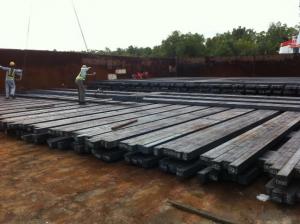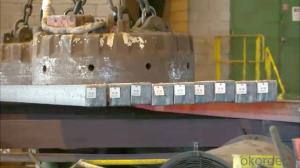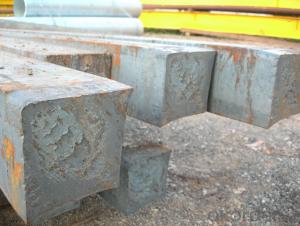Hot Rolled Square Steel Billet 3SP Standard 150mm
- Loading Port:
- Shanghai
- Payment Terms:
- TT OR LC
- Min Order Qty:
- 2000 m.t.
- Supply Capability:
- 10000 m.t./month
OKorder Service Pledge
OKorder Financial Service
You Might Also Like
Structure of Hot Rolled Square Steel Billet 3SP Standard 150mm

Description of Hot Rolled Square Steel Billet 3SP Standard 150mm
PPGI is made by cold rolled steel sheet and galvanized steel sheets as baseplate, through the surface pretreatment (degreasing, cleaning, chemical conversion processing), coated by the method of continuous coatings (roller coating method),
and after roasting and cooling. Zinc coating: Z60, Z80, Z100, Z120, Z180, Z275, G30, G60, G90
Alu-zinc coating: AZ60, AZ80, AZ100, AZ120, AZ180, G30, G60, G90
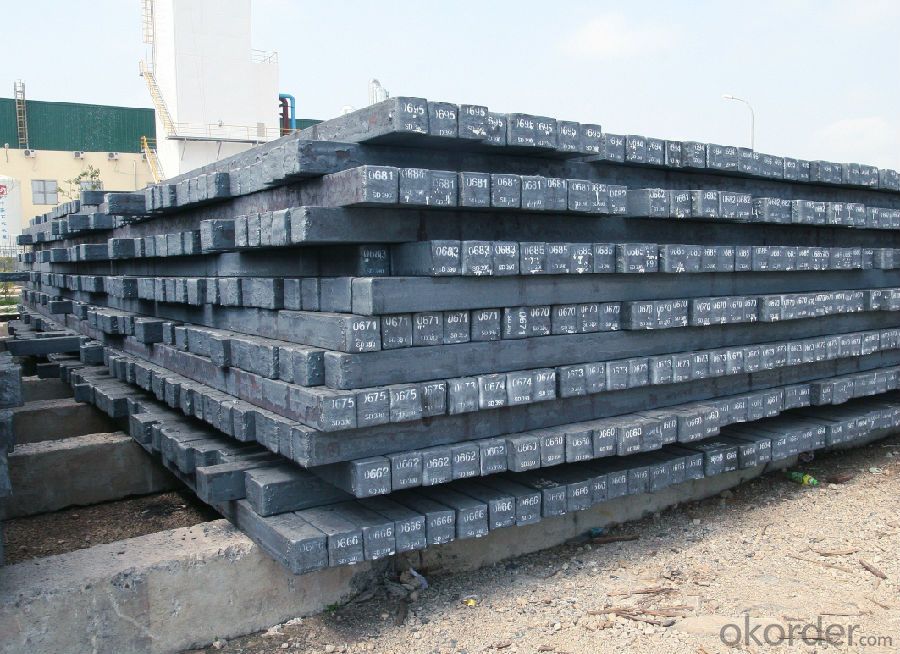
Main Feature of Hot Rolled Square Steel Billet 3SP Standard 150mm
1) Excellent corrosion resistance: The zinc layer provides a good protection of Pre-painted Galvanizeed Steel Sheet.
2) High heat resistance: The reflective surface of the material aids in efficiently reflecting the sunlight away and in turn reducing the amount of heat transmitted. The thermal reflectivity converts into energy savings.
3) Aesthetics: Pre-Painted Galvanized steel sheet is available in plethora of patterns and multiple sizes as per the requirements that given by our customers.
4) Versatility: can be used in the various areas.Standard seaworthy export packing: 3 layers of packing, inside is kraft paper, water plastic film is in the middle and outside GI steel sheet to be covered by steel strips with lock, with inner coil sleeve.
Applications of Hot Rolled Square Steel Billet 3SP Standard 150mm
1) Automotive bodies: filters, fuel tanks, etc.
2) Construction materials: roofings, welding pipes,
3) Electric and electronic appliances: computer cans, etc.
4) Steel cans: containers, etc.
5) Steel furniture: washing machines, refrigerators, microwaves, etc.
6) Drums
7) Office equipment: printer, recorders, etc.
8) Motors and transformers
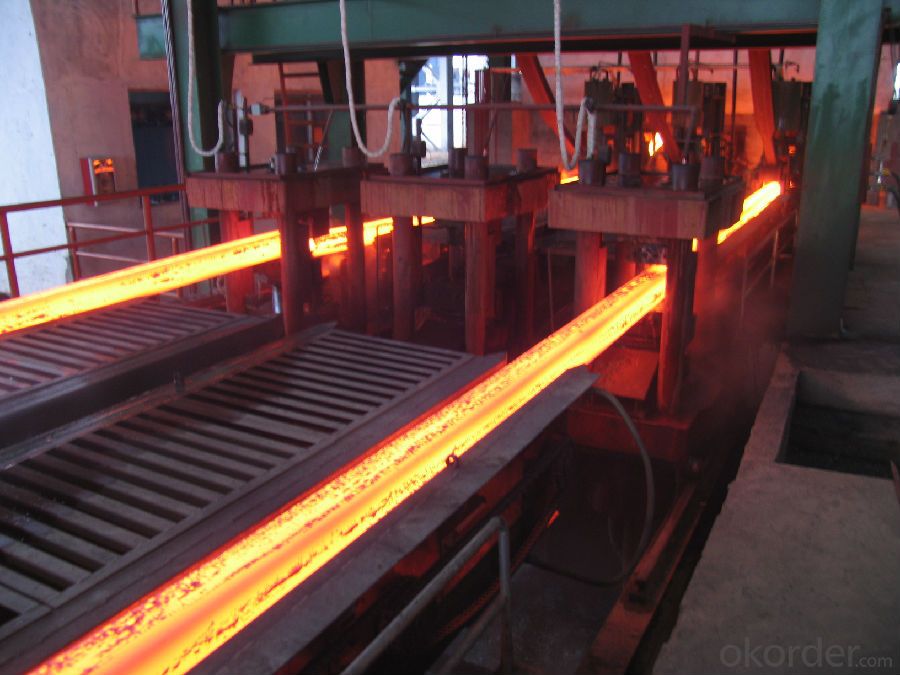
Specifications of Hot Rolled Square Steel Billet 3SP Standard 150mm
| Classified symbol | Yield Point Minimum N/mm2 | Tensile Strength Minimum | Elongation Minimum % | Application | ||||
| N/mm2 | Nominal Thickness mm (t) | |||||||
| JIS | Yogic | 0.25-0.4 | 0.4-0.6 | 0.6-1.0 | 1.0-1.6 | |||
| G3312 | specification | |||||||
| CGCC | CGCC | -205 | -270 | -20 | -21 | -24 | -24 | Commercial |
| CGCD | CGCD | --- | 270 | --- | 27 | 31 | 32 | Drawing |
| --- | CG340 | 245 | 340 | 20 | 20 | 20 | 20 | Structural |
| CGC400 | CG400 | 295 | 400 | 16 | 17 | 18 | 18 | Structural |
| CGC440 | CG440 | 335 | 440 | 14 | 15 | 16 | 18 | Structural |
| CGC490 | CG490 | 365 | 490 | 12 | 13 | 14 | 16 | Structural |
| CGC570 | CG570 | 560 | 570 | --- | --- | --- | --- | Structural |
| ASTM Designation | Yield Point Minimum | Tensile Strength Minimum | Elongation Minimum % | Application | Q/BQB 445-2004(China standard) | ASM A653/A653M | JISG 3312 | |
| ksi(MPa) | ksi(MPa) | TDC51D+Z | (CS TYPE A+Z) | CGCC | ||||
| A653(M)-99 CS TYPE A,B,C | --- | --- | --- | Commercial | TDC52D+Z | CGCD | ||
| A653(M)-99 FS | --- | --- | --- | Lock Forming | TS250GD+Z | (G250+Z) | - | |
| A653(M)-99 DS | --- | --- | --- | Drawing | TS300GS+Z | (G300+Z) | CGC 400 | |
| A653(M)-99 SS Grade33(230) | 33(230) | 45(310) | 20 | Structural | TS350GD+Z | (G350+Z) | CGC490 | |
| A653(M)-99 SS Grade37(255) | 37(255) | 52(360) | 18 | Structural | TS550GD+Z | (G550+Z) | CGC570 | |
| A653(M)-99 SS Grade40(275) | 40(275) | 55(380) | 16 | Structural | ||||
| A653(M)-99 SS Grade50(345) | 50(345) | 65(450) | 12 | Structural | ||||
| A653(M)-99 SS Grade80(550) | 80(550) | 82(570) | --- | Structural | ||||
FAQ of Hot Rolled Square Steel Billet 3SP Standard 150mm
We have organized several common questions for our clients,may help you sincerely:
1. How Can I Visit There?
Our company is located in Tianjin City, China, near Beijing. You can fly to Tianjin Airport Directly. All our clients, from home or aboard, are warmly welcome to visit us!
2. How Can I Get Some Sample?
We are honored to offer you sample.
3. Why choose CNBM?
1, ISO, BV, CE, SGS approved.
2, Competitive price and quality.
3, Efficient service team online for 24 hours.
4, Smooth production ability(50000tons/month) .
5, quick delivery and standard exporting package.
6, Flexible payment with T/T, L/C, Paypal, Kunlun bank, etc.
- Q:What is billet?
- At present, the casting process has been basically eliminated.Mainly from the shape of two:Slab: the ratio of section width and height is larger, which is mainly used for rolling plate.Billet: cross section width, height equal, or difference is not big, mainly used for rolling steel, wire.
- Q:What are the safety precautions to be taken while handling steel billets?
- When handling steel billets, there are several safety precautions that should be followed to ensure the well-being of individuals as well as the integrity of the material. Some key safety precautions include: 1. Personal Protective Equipment (PPE): It is essential to wear appropriate PPE such as gloves, safety glasses, and steel-toed boots to protect against potential injuries. Steel billets are heavy and can cause severe harm if dropped or mishandled. 2. Proper Lifting Techniques: When lifting steel billets, it is crucial to use proper lifting techniques, such as bending at the knees and keeping the back straight. This helps prevent strains, sprains, and other musculoskeletal injuries. 3. Adequate Training: Workers should receive proper training on how to handle steel billets safely. This includes understanding the weight and dimensions of the billets, knowing how to move them safely, and being aware of potential hazards. 4. Secure Storage and Transportation: Steel billets should be stored and transported in a secure manner to prevent accidents. They should be properly stacked, secured, and not overloaded to avoid falling or shifting during handling. 5. Clear Communication: In a work environment where multiple individuals are involved in handling steel billets, clear communication is essential. This includes using appropriate signals and verbal communication to coordinate movements and ensure everyone's safety. 6. Inspect Equipment: Before handling steel billets, it is important to inspect the equipment being used, such as cranes, forklifts, or other lifting devices. This helps identify any potential issues or malfunctions that could compromise safety. 7. Regular Maintenance: Regular maintenance of equipment used for handling steel billets is crucial to ensure their proper functioning. This includes inspections, repairs, and replacements as needed. 8. Hazard Identification: Workers should be trained to identify potential hazards associated with handling steel billets, such as sharp edges, hot surfaces, or slippery floors. Identifying and addressing these hazards promptly can prevent accidents and injuries. 9. Ergonomic Considerations: Ergonomic factors should be considered when designing workstations and handling procedures. This includes ensuring proper height and reach distances, providing adequate space for movement, and using tools or equipment that reduce strain on the body. 10. Emergency Response: Lastly, workers should be aware of emergency response procedures in case of accidents or injuries. This includes knowing the location of first aid kits, fire extinguishers, emergency exits, and how to report incidents to supervisors. By following these safety precautions, individuals can mitigate the risks associated with handling steel billets and create a safer work environment.
- Q:How are steel billets used in the manufacturing of food processing equipment?
- Steel billets are used in the manufacturing of food processing equipment as they serve as the primary raw material for shaping and forming various components such as frames, supports, blades, and cutting tools. These billets are heated, rolled, and machined into desired shapes and sizes to create durable and robust equipment that can withstand the demanding conditions of food processing operations while ensuring hygiene, safety, and efficiency.
- Q:How are steel billets used in the production of marine vessels?
- Steel billets are used in the production of marine vessels as they serve as the raw material for various components and structures. These billets are typically shaped and processed to create different parts such as hulls, frames, decks, and superstructures. By being molded and welded together, steel billets provide the necessary strength, durability, and structural integrity required for marine vessels to withstand the harsh conditions of the sea.
- Q:How are steel billets distributed in the market?
- Steel billets are distributed in the market through various channels such as steel mills, steel service centers, and steel distributors. These entities source the billets from steel producers and then supply them to various industries and customers, including construction, manufacturing, and infrastructure. The distribution process involves logistics, warehousing, and transportation to ensure timely delivery to the end-users.
- Q:How do steel billets come out?
- Three, steel rolling:Rolling steel or continuous casting billet into various steels by rolling mill
- Q:What are the properties of alloy steel billets?
- Alloy steel billets are highly sought after in various industries due to their numerous desirable properties. Chief among these is their exceptional strength and toughness, which is attributed to the presence of alloying elements like chromium, nickel, molybdenum, and vanadium. This heightened strength enables the billets to withstand heavy loads and high temperatures, making them ideal for applications that demand resistance to wear and tear. Furthermore, alloy steel billets possess excellent corrosion resistance, rendering them perfect for use in harsh environments or exposure to chemicals. This resistance to corrosion not only extends the lifespan of the billets but also ensures their durability over time. Moreover, alloy steel billets exhibit good machinability, allowing them to be easily shaped, formed, and fabricated into various products or components. This quality facilitates the creation of intricate and complex designs, making them versatile for use in automotive, construction, and manufacturing industries. Another noteworthy property of alloy steel billets is their ability to undergo heat treatment. This process enables the adjustment of their mechanical properties, such as hardness and ductility, to meet specific requirements. Heat treatment enhances the strength and toughness of the billets, making them even more suitable for heavy-duty applications. Lastly, alloy steel billets possess excellent weldability, enabling them to be easily joined together through various welding techniques. This characteristic adds to their versatility and allows for the construction of larger structures or the fabrication of complex assemblies. In conclusion, the properties of alloy steel billets, including strength, corrosion resistance, machinability, heat treatability, and weldability, make them extremely valuable in industries where high performance and durability are crucial.
- Q:What are the different types of defects that can occur during steel billet production?
- There are several types of defects that can occur during steel billet production. Some common defects include surface cracks, internal voids or inclusions, segregation, surface roughness, and dimensional deviations. Surface cracks can occur due to improper cooling or handling, while internal voids or inclusions can be caused by impurities in the raw materials. Segregation refers to uneven distribution of elements within the billet, leading to inconsistent properties. Surface roughness can result from inadequate surface preparation or poor rolling conditions. Dimensional deviations can occur due to improper alignment or adjustment of the equipment.
- Q:How are steel billets used in the manufacturing of automotive components?
- Steel billets are used in the manufacturing of automotive components as the starting material for various forging and machining processes. These billets are heated, shaped, and then further processed to create different automotive parts like crankshafts, connecting rods, gears, and axles. The high strength and durability of steel make it an ideal choice for these critical components, ensuring the safety and performance of vehicles.
- Q:What are the advantages of using steel billets in manufacturing?
- There are several advantages of using steel billets in manufacturing processes. Firstly, steel billets offer exceptional strength and durability. Steel is known for its high tensile strength, making it ideal for applications that require heavy loads or resistance to wear and tear. This strength ensures that products made from steel billets are long-lasting and can withstand harsh conditions, increasing their lifespan and reducing the need for frequent replacements. Secondly, steel billets are highly versatile. They can be easily molded and shaped into various forms, allowing manufacturers to create a wide range of products with different designs and specifications. This versatility makes steel billets suitable for a diverse range of industries, including construction, automotive, machinery, and appliances. Furthermore, steel billets are cost-effective. Steel is one of the most affordable and readily available materials in the manufacturing industry. Its widespread availability ensures a steady supply, reducing the cost of production. Additionally, steel's durability minimizes maintenance and replacement expenses, saving money in the long run. Another advantage of using steel billets is their eco-friendliness. Steel is a highly recyclable material, and using steel billets in manufacturing promotes sustainability. Recycling steel reduces the need for mining raw materials, conserves energy, and decreases carbon emissions. Therefore, steel billets contribute to a greener manufacturing process and support environmental conservation efforts. Lastly, steel billets offer excellent performance characteristics. Steel has exceptional thermal and electrical conductivity properties, making it suitable for applications that require heat dissipation or electrical conduction. Additionally, steel is resistant to corrosion, rust, and fire, adding an extra layer of protection to products manufactured using steel billets. In conclusion, the advantages of using steel billets in manufacturing are its strength and durability, versatility, cost-effectiveness, eco-friendliness, and exceptional performance characteristics. These advantages make steel billets a preferred choice for various industries, ensuring high-quality products that withstand the test of time.
1. Manufacturer Overview |
|
|---|---|
| Location | |
| Year Established | |
| Annual Output Value | |
| Main Markets | |
| Company Certifications | |
2. Manufacturer Certificates |
|
|---|---|
| a) Certification Name | |
| Range | |
| Reference | |
| Validity Period | |
3. Manufacturer Capability |
|
|---|---|
| a)Trade Capacity | |
| Nearest Port | |
| Export Percentage | |
| No.of Employees in Trade Department | |
| Language Spoken: | |
| b)Factory Information | |
| Factory Size: | |
| No. of Production Lines | |
| Contract Manufacturing | |
| Product Price Range | |
Send your message to us
Hot Rolled Square Steel Billet 3SP Standard 150mm
- Loading Port:
- Shanghai
- Payment Terms:
- TT OR LC
- Min Order Qty:
- 2000 m.t.
- Supply Capability:
- 10000 m.t./month
OKorder Service Pledge
OKorder Financial Service
Similar products
New products
Hot products
Related keywords
